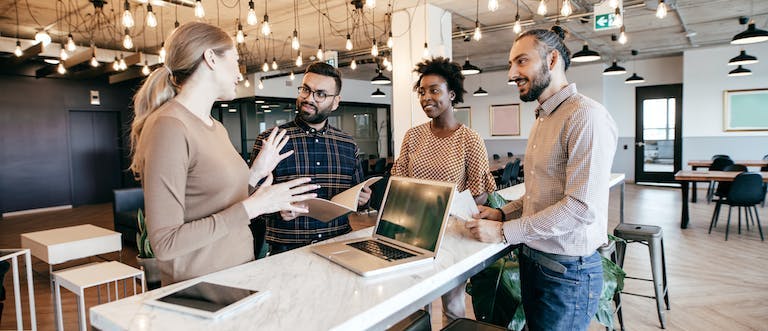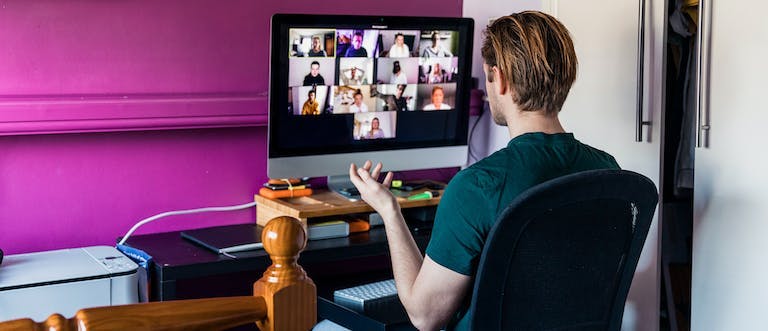Do you know your B2B Buyer’s Journey?
Following up from our introductory blog, 3 Practices To Rev Your B2B Growth Big Village, this post is our first of 3 drill down posts focused on understanding the buyer journey, Mapping the B2B Buyer Journey. In the coming weeks, we’ll also cover connecting the journey to the sales process and optimizing digital tools to foster brand engagement.

When it comes to examining the buyer journey, there is no one size fits all. For some the journey is quite simple but for most, it is quite complex. Fast forward to today’s socially distanced world and this process becomes even more complicated. In-person meetings have moved online, and socially distancing sales reps are seeking new strategies to help customers make good decisions.
In some ways the B2B buyer journey has been turned on its head making this a critical time to update your understanding of it – the nuances, pain points and key opportunities. In our experience with B2B leaders, there are three key questions to answer:
-
How has your buyers’ journey evolved over the past 6 months?
-
How have you embraced those changes?
-
Where are the opportunities to increase brand awareness, consideration, selection?
Keeping it Fresh: Monitoring the Evolution of the Buyer Journey

For many decades we have been working under the belief that the buyers’ journey is linear. In fact, we have assigned functional ownership and key hands-off to different parts of our organizations – Marketing, Sales, Customer Support – to optimize our efforts to close the deal.
At the same time, the buyers’ world has been fundamentally changing. Technology, the primary change agent, has opened the door to unlimited information providing buyers with the tools and the access to grow their knowledge about products and services and the brands that offer them. What began as a conduit to information has evolved into a sea of unending noise that never turns off, it is ‘always on’.
So, it is no surprise that B2B buyers face information overload, charged with doing right by their organization to make large-scale purchase decisions; a seemingly daunting task that can paralyze the best of us.
Let’s break it down. One of the simplest and easiest ways to understand the buyers’ journey is to identify the jobs they are trying to complete. Gartner applies this thinking in its “Jobs-to-be-Done” framework ¹ which identifies 6 rather generic tasks that can be applied to many situations:
- Problem identification – what is the trigger, the need, the problem?
- Solution exploration – what solutions are available?
- Requirements building – what do we need the solution to do?
- Supplier consideration – which brands can do what is needed?
- Validation of capabilities – do we have the right solution and the right brand?
- Consensus creation – how do we get everyone on board?
One of the most essential aspects of this framework is the fact that nearly every successful B2B purchase progresses through the first four tasks. However, buyers simultaneously address tasks 5 and 6 throughout the entire buying process. This is not a linear process but rather a series of circular activities, one informing the other as knowledge is gained and refined to complete each and every task.
How much does this represent your buyers’ journey? What are the jobs your buyers are trying to accomplish and how can you help them do so?
Because, when you can:
- Enable the buyer by guiding them through their tasks to completion
- Build their confidence to make sound, reasonable, decisions for their company
- Simplify the purchase process to make it as efficient as possible for them
… your organization will be the brand that is chosen.
We need look no further than the benchmark set by Amazon.
Keeping it Real: Go Digital or Go Home

Clare Dorrian, CMO at SugarCRM notes that “The customer journey has changed dramatically, most notably with longer sales cycles and an increased reliance on digital. These changes mark a permanent shift that makes empathy and personalization the hallmarks of the new customer experience.” ²
The B2B buyer is inundated with information, they are strapped for time and their journey has become ever more complicated as they must deal with multiple decision-makers inside their organization, each bringing additional information to the process.
Is it any wonder why the sales cycle has increased?
And yet McKinsey is quick to remind us that agility will be essential in developing new growth strategies, since the early days of the COVID-19 crisis show how quickly new opportunities can emerge, as well as how rapidly some thriving markets can slow down. Remote sales interactions will be the norm for the foreseeable future as physical-distancing requirements and travel restrictions persist.³ Businesses are then tasked with amplifying and optimizing remote experiences to make them efficient, effective and memorable.
Embracing digital is no longer a nice to have, it is a must have to engage with buyers
First, turbo-charging eCommerce growth. In a recent McKinsey survey, 96% of B2B organizations stated that COVID-19 necessitated changes in their go-to-market models. Most had to shift from in-person interactions to remote sales, a change that nearly two-thirds of B2B decision-makers believe is as effective or more so than the old sales model. Not surprisingly, this shift has led to double-digit growth in eCommerce.
No matter where you may be on your digital sales journey, there is always opportunity to optimize. But to gauge progress you must monitor change. Change is most certainly a function of new tools, features, functions but it is also about adoption, conversion and scale. Here are some of the essential questions you should be able to answer about your digital sales initiatives that will help you gauge how successful your actions have been to your top and bottom line:
- How have your adoption and conversion rates changed?
- How much of your sales have converted to eCommerce over the last 6 months?
- Correspondingly, how has use of your offline sales channels changed, during the same period?
- Have the number of line items per order changed, when comparing eCommerce to offline purchases?
- Have you been able to re-direct FTEs, previously involved in offline purchases, to other important tasks?
- How has your cost of sales changed, during this same time period?
For some organizations, this type of change cannot be rolled out overnight, it must be staged across segments, sectors, and geographies. So much to think about but critical elements that should be a part of your digital sales initiatives.
Keeping it Focused: Elevating the Power of Your Brand

Outside of modifications to the sales process, a digital-first strategy should be aimed at elevating your brand in ways that will align with the buyer’s journey and their jobs to be done.
- Forrester Research reports that 74% of B2B buyers do at least half their research online before making an offline purchase.
- And according to SiriusDecisions, 70% of the buyer’s journey is complete before a buyer even reaches out to sales.⁴
Revisiting the jobs to be done framework should help you identify the questions buyers are seeking to answer. Elevating the power of your brand means doing so in a manner that makes it easier for prospects and customers to relate to your brand, to see themselves using your brand because it helps them complete their tasks.
- Problem identification – what is the trigger, the need, the problem?
- Solution exploration – what solutions are available?
- Requirements building – what do we need the solution to do?
- Supplier consideration – which brands can do what is needed?
- Validation of supplier capabilities – do we have the right solution and the right brand?
- Consensus creation – how do we get everyone on board?
As you think about how best to answer these questions, the most essential buyer behaviors to impact are: enablement, confidence and efficiency. More to come in our next blog where we will share examples of how brands are successfully answering these questions.
We’ve outlined the questions your brand should answer, now let’s touch on the importance of meeting customers where they are. McKinsey’s recent B2B COVID research points to the fact that B2B buyers are more likely to cite digital than traditional channels when asked about the best way to research suppliers – websites of suppliers, online materials, and live chats were rated the most valuable resources.⁵ And yet, we live in an omnichannel environment where digital and traditional channels co-exist. Many believe this is a temporary moment in time where the past, impacted by disruption to catch-up to the future, is challenging those still struggling to embrace digital. And the penalty is higher cost of sales due to inefficiencies compounded by a loss of opportunity. But let’s be real, the omnichannel environment is not going away any time soon, but as disruptions outside of our control continue to emerge, all businesses need to be prepared to pivot quickly in order to move their business forward.
An example of the shift in B2B channels is the use of social, a controversial topic with some firms fully embracing social while others chose to shy away completely. In the face of the current pandemic, agendas and schedules have been thrown out the window and the lines between life and work have blurred. With these changes at play, social media appears to be a more viable option for B2B firms than previously thought. An IDC study found that 75% of B2B buyers and eight out of 10 C-level execs use social media to make purchasing decisions.⁶
At the same time, eMarketer points to the fact that while many B2B marketers have reduced their overall marketing spend, the use of paid digital channels has surged amid the pandemic. In combination with the integration of social channels, LinkedIn stands out as an actionable platform to increase brand awareness, consideration and selection. A recent study by MotionCue points to the fact that 54% of marketers have shared brand videos on LinkedIn. Out of those, 78% believe it helped their business.7
There are many options to consider; the answers lie in understanding your buyers and crafting a plan where marketing and sales take on joint responsibility to help buyers complete the purchase jobs they need to accomplish.
Where Big Village Comes In
At Big Village we work with B2B clients day in and day out to understand their buyers and how best to engage with them, create solutions and develop marketing programs that are highly visible and resonate with target segments.
Our tenants for exploring the Buyer Journey focus on:
- Agility is the Name of the Game: Competition is fierce, customers are stretched for time and resources are limited. With all these factors we have embraced agile approaches and solutions to react quickly and ideate throughout to create optimal solutions and processes.
- A Focus on Actionability: Our customer explorations focus on identifying gaps and pain points and designing the right next steps to capitalize on findings. We do not believe in research for research sake, defined action steps are a key outcome to our journey explorations.
- Leveraging Advanced Techniques for Precise Targeting: With the world moving to digital there are enhanced techniques to target desired buyer segments. We leverage digital audience tools to identify and target B2B segments of interest, enhancing ROI of marketing efforts.
What’s next?
Stay tuned for our next blog in this four-part series, Connecting the Buyer Journey to the Sales Process, where we will drive deeper into digital channels, examples of brand power and new metrics to effectively manage the sales pipeline.
Big Village: B2B is in our DNA. We have spent the last 50+ years helping businesses identify the most effective ways to create sustainable growth. In today’s environment, your ability to tap into your markets, competitors, prospects and customers and to effectively synthesize the learning for action, is essential. We have the tools, techniques and the expertise to help you succeed!
Written by Linda Shea, EVP Business Advisory Services, Big Village Insights.
- “CSO Update – The new B2B buying journey and its implications for sales” Gartner. 2019.
- “How Has the Customer Journey Shifted?” CMSWire. May 2020.
- “A post–COVID-19 commercial-recovery strategy for B2B companies.” McKinsey. July 2020.
- “How Mapping the Buyer’s Journey Can Lead to More Revenue.” CustomerThink. May 2018.
- “A post–COVID-19 commercial-recovery strategy for B2B companies.” McKinsey. July 2020.
- “6 words to guide you on your B2B content marketing journey.” Biz Community. September 2020.
- “Five Useful Tips For Increasing B2B Engagement With Corporate Videos.” Forbes. September 2020.

